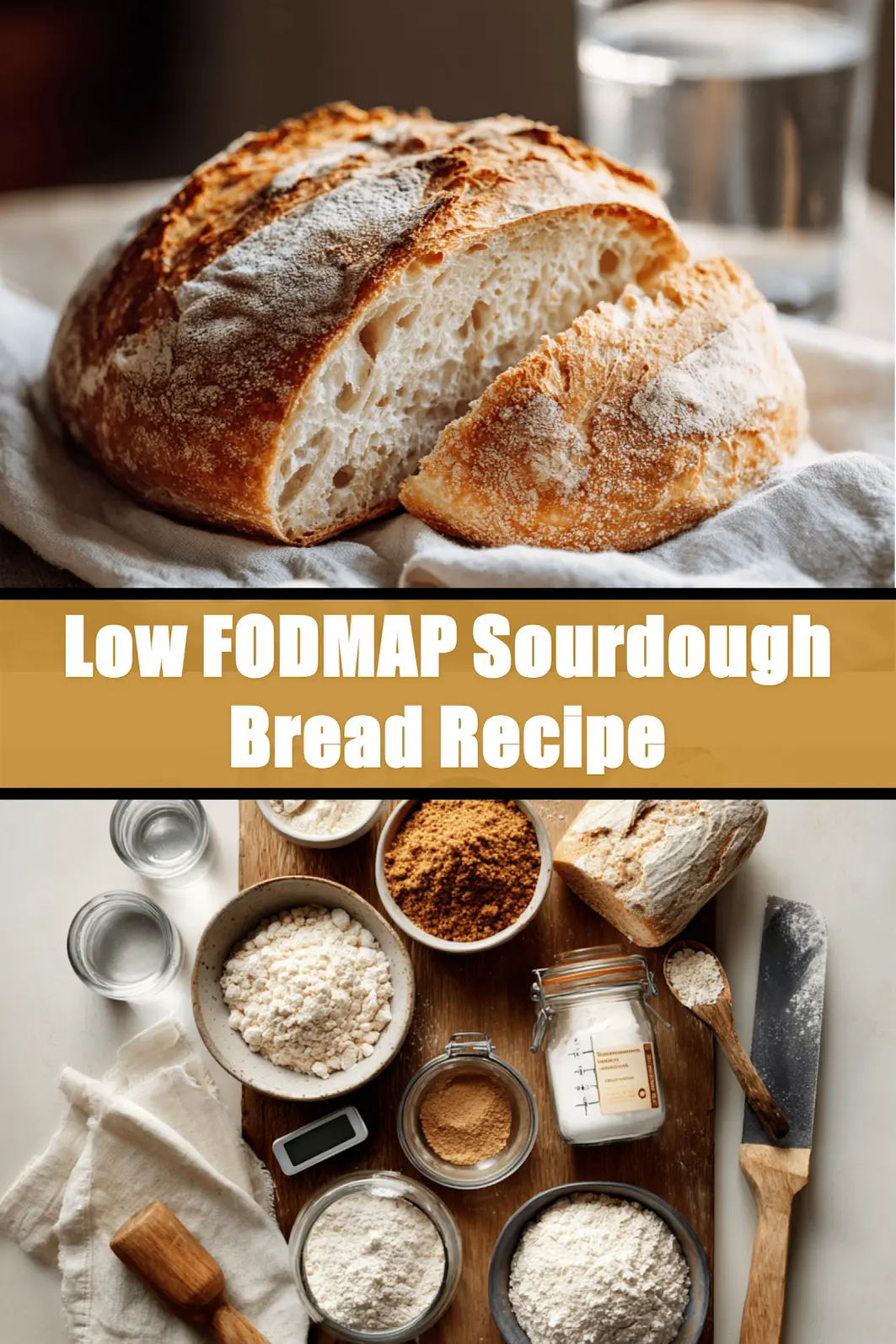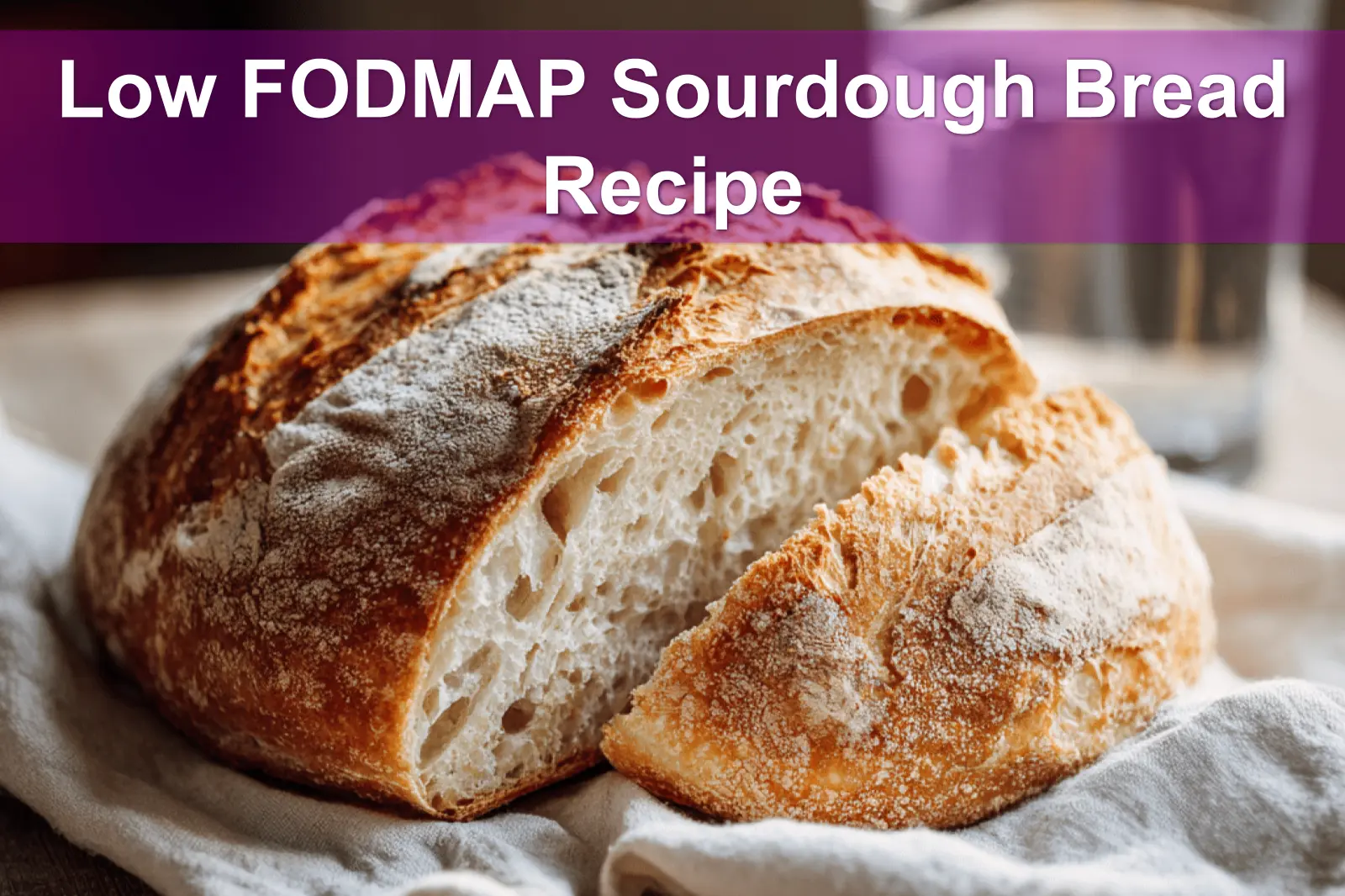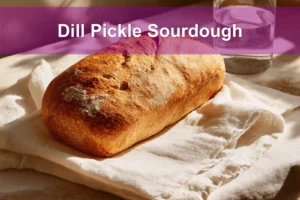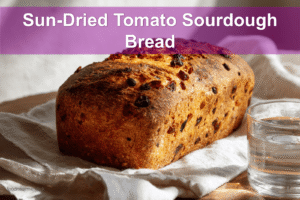Ever notice how the tangy, earthy smell of a sourdough loaf cooling on the counter just feels like Sunday morning? This Low FODMAP Sourdough Bread Recipe is blowing up on Pinterest and Reddit and for good reason. It’s cozy, bloat-free, and beginner-friendly. No fancy tools. Just time, patience, and that perfectly chewy crumb.
It’s a homemade bread that won’t wreck your stomach. Just flour, salt, and a long, lazy ferment. Pantry staples you already have. Think grandma’s kitchen meets gentle-on-the-gut baking. All the feel-good, none of the regret. Full details in the blog!
My grandma taught me to make sourdough with a starter she named “Bubba.” True story. I’ve been tweaking her method ever since for my tastebuds and my gut. No shortcuts, no fads. Just good bread that loves you back. I tested it. You’ll love the secret!
Print
Low FODMAP Sourdough Bread Recipe
- Total Time: 1 day 12 hours
- Yield: 1 loaf 1x
- Diet: Low FODMAP
Description
This low FODMAP sourdough bread uses whole grain spelt flour and a slow fermentation process to create a flavorful and easy-to-digest bread perfect for those following a low FODMAP diet.
Ingredients
- Bread Flour 300 grams
- Whole Grain Spelt Flour 150 grams
- Water 300 grams
- Sourdough Starter 50 grams
- Salt 9 grams
Instructions
- Take 25 grams of sourdough starter out of your fridge and mix it with 25 grams of whole grain spelt flour and 25 grams of water in a glass jar. Stir until no dry flour remains and let it sit covered at room temperature for 4-12 hours until doubled in size.
- Once starter has doubled, mix both flours, water, salt, and 50 grams of sourdough starter in a bowl. Stir until combined and let rest covered for 30 minutes.
- Perform three sets of stretch and folds every 30 minutes to build dough strength, then let dough rise covered at room temperature for 5-10 hours until doubled in size.
- Pre-shape dough into a ball on floured surface, rest uncovered for 20-30 minutes.
- Final shape dough into a rectangle, roll it up, and place seam side down in loaf pan lined with parchment if needed.
- Cover and refrigerate dough overnight or for 8-12 hours for second rise.
- Remove dough from fridge and allow it to rise until puffed above loaf pan.
- Preheat oven to 450°F with a metal pan at bottom rack for steam.
- Bake bread in middle rack, pour hot water into pan for steam, bake 20 minutes.
- Remove steam pan, reduce temperature to 400°F, bake another 15-20 minutes until internal temp is 190°F.
- Cool bread on wire rack for at least one hour before slicing.
Notes
- Use King Arthur brand Bread Flour and Bob’s Red Mill brand whole grain spelt flour for best results
- Line loaf pan with parchment paper if it is not non-stick
- Prep Time: 20 minutes
- Cook Time: 40 minutes
- Category: Sourdough
- Method: Baked
- Cuisine: American
Nutrition
- Serving Size: 1 slice
- Calories: 150 kcal
- Sugar: 0.5g
- Sodium: 300mg
- Fat: 1.5g
- Saturated Fat: 0.3g
- Unsaturated Fat: 1g
- Trans Fat: 0g
- Carbohydrates: 30g
- Fiber: 3g
- Protein: 6g
- Cholesterol: 0mg
Why This Recipe Works
This low FODMAP sourdough bread recipe is magic for sensitive tummies thanks to the long fermentation process. The natural sourdough starter pre-digests all those pesky FODMAPs, like fructans, making the bread gentle on digestion without losing any flavor. If you’ve been missing real bread, this is the recipe to bring back that chewy, crusty joy!
It’s also beginner-friendly because sourdough is forgiving. A little patience and some simple stretch-and-fold steps transform humble pantry staples into bakery-level bliss. Plus, there’s something so satisfying about watching your dough rise it’s like a science experiment, but tastier.
Key Ingredients and Tools

All you need is five ingredients: bread flour, whole grain spelt flour, water, salt, and a homemade sourdough starter. The spelt flour keeps things low FODMAP, while the bread flour adds structure for that perfect crumb.
Pro Tip: Use a kitchen scale to measure everything precisely. For tools, a mixing bowl, wooden spoon, and a trusty loaf pan are must-haves. If your loaf pan isn’t non-stick, line it with parchment paper (no final loaf left behind!).
| Tool | Why You Need It |
|---|---|
| Kitchen Scale | Ensures the right flour-to-water ratio. |
| Mixing Bowl | Plenty of room to mix and rise. |
| Loaf Pan | Shapes your bread for easier slicing. |
Step-by-Step Process
First, feed your sourdough starter and let it double overnight. The next morning, mix the starter with both flours, water, and salt. Stir until no dry flour remains don’t worry if it’s sticky! Cover the bowl and let it rest for 30 minutes.
Then comes the fun: stretch-and-folds. Every 30 minutes for the first 1–2 hours, stretch each “corner” of the dough and fold it over itself. These little movements build structure and strength. After that, let your dough rise until it doubles in size this step can take up to 10 hours. Remember, sourdough is all about patience!
Finally, shape your dough for the loaf pan and let it rest overnight in the fridge for cold-proofing. The slow fermentation adds even more flavor and helps keep it low FODMAP. The next day, let it finish rising on the counter until puffed and ready to bake.
Troubleshooting Common Issues
Sourdough not rising? Your starter might be sluggish. Make sure it’s bubbly and active before adding it to the dough. Bread too dense? It’s likely under-proofed; give it more time to rise.
Pro Tip: Kitchen too cold? Place your dough near a warm oven or wrap the bowl in a towel to keep it cozy. Still struggling? Don’t be afraid to try again sourdough has a learning curve, but it’s worth it!
| Issue | Cause | Fix |
|---|---|---|
| Dense Loaf | Under-proofed | Let it rise longer. |
| Starter Inactive | Too cold or not fed | Feed and warm it up. |
| Sticky Dough | Flour type | Add a little extra flour. |
Serving, Storing, and Tweaks
Slice your fresh, crusty low FODMAP sourdough bread with a sharp knife and serve it toasted with butter, smashed avocado, or a drizzle of honey. It’s just as good paired with a hearty soup or anything cozy!
To store, wrap it in a clean kitchen towel or keep it in a bread bag at room temp for up to 3 days. For longer storage, freeze slices and pop them in the toaster whenever you need a quick, comforting bite.
Feeling creative? Add some flavor twists during the mixing stage think sunflower seeds, fresh rosemary, or cracked pepper. You’ll have the most impressive loaf at the family brunch!
Expert Insight: The Science Behind Low FODMAP Sourdough Bread
Using traditional fermentation, this Low FODMAP Sourdough Bread Recipe naturally reduces fermentable sugars that can trigger digestive discomfort. The slow fermentation process breaks down FODMAPs, making it a smarter choice for those sensitive to certain carbohydrates while still delivering classic sourdough flavor and texture.
For more delicious recipes and cooking inspiration, follow me on Facebook, Pinterest and Reddit!
Behind the Loaf
Making this Low FODMAP Sourdough Bread Recipe reminded me of afternoons spent baking with Rachelwhere flour ends up everywhere but the dough, and laughter fills the kitchen. Balancing flavor with dietary needs felt like a welcome challenge, turning our usual chaos into a cozy, comforting ritual.
FAQs ( Low FODMAP Sourdough Bread Recipe )
Is sourdough bread low FODMAP?
Yes, traditional sourdough can be lower in FODMAPs because the long fermentation allows lactic acid bacteria to break down some fermentable carbohydrates. Using a low FODMAP flour blend and extending the ferment time helps reduce FODMAP content further. Individual tolerance still varies, so start with a small serving to test how you react. If you have severe IBS, check with a registered dietitian for personalized advice.
What flours are safe for a Low FODMAP sourdough?
Safe choices often include rice flour, certified gluten-free oat flour, buckwheat flour, and certain low FODMAP commercial gluten-free blends available in the USA. Spelt or sourdough made from wheat may be tolerated by some people in small portions, but they can still be high FODMAP for others. Avoid high FODMAP flours like regular rye and large amounts of whole wheat unless you know you tolerate them. Always check package labels and start with tested servings.
How long should I ferment to reduce FODMAPs?
A longer fermentation generally helps reduce FODMAPs, so aim for a bulk ferment plus a proof that totals 12 to 24 hours, or use an overnight cold retard in the refrigerator. The exact time depends on your starter activity, room temperature, and flour choice, so watch the dough rather than the clock alone. Cold retarding for 12 to 18 hours is a practical method in many home kitchens. Remember that longer fermentation improves digestibility but also changes flavor and texture.
Can I use store-bought sourdough starter?
Yes, you can use a store-bought wild yeast sourdough starter, but check the label to avoid additives or unexpected ingredients. If the starter is dried or from a different flour base, feed and refresh it with your chosen low FODMAP flours for a few cycles so it adapts. Many bakers also prefer to build their own starter from scratch using the recipe flour for best results. Avoid starters that list sugars or preservatives on the ingredient list.
How should I store Low FODMAP sourdough bread to keep it fresh?
Store your sourdough at room temperature in a breathable bag or a cloth-lined basket for 1 to 2 days to keep the crust and crumb in good shape. For longer storage, slice and freeze the bread in airtight freezer bags and thaw slices as needed or toast them straight from frozen. Avoid refrigeration, which makes bread stale faster, unless you plan to use it in recipes. To refresh the crust, pop the loaf into a 350 F oven for 5 to 10 minutes.

Wrapping Up Your Low FODMAP Sourdough Bread Adventure
This Low FODMAP Sourdough Bread Recipe turns simple ingredients into a golden, chewy loaf that’s gentle on your tummy and full of homemade charm. It’s an easy, patient bake that rewards you with comforting, bakery-worthy bread perfect for breakfast or a cozy snack.
Want to mix things up? Try folding in some toasted sunflower seeds or a pinch of fresh rosemary for a little extra flair. Wrap leftovers in a kitchen towel to keep the crust crisp, or freeze slices for busy mornings the perfect way to stretch this family-friendly recipe.
Give it a whirl and share your baking wins (or funny fails!) did this remind you of a treasured kitchen ritual? Pass it along to friends who need a little less stress and a lot more joy in their homemade bread. Happy baking, friends!












